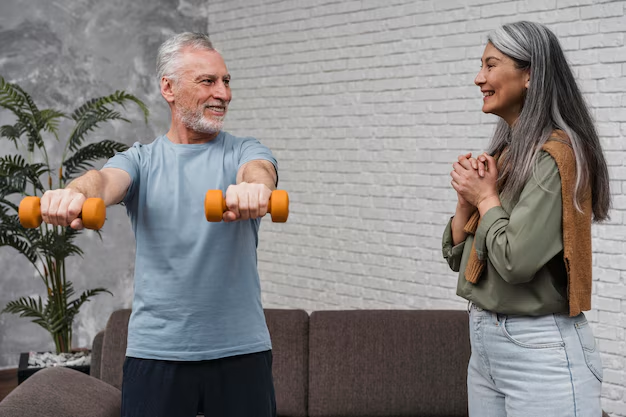Healthy Aging and Fitness for Seniors As we age, maintaining physical health and fitness becomes increasingly important. Healthy aging is not merely about adding years to life but enhancing the quality of life in those years. Engaging in regular physical activity can help seniors maintain their independence, improve their overall well-being, and reduce the risk of chronic diseases. In this blog, we will explore the significance of fitness in healthy aging, appropriate exercises for seniors, and practical tips to help older adults stay active and healthy.
The Importance of Fitness in Healthy Aging
Regular physical activity plays a vital role in promoting healthy aging. It provides numerous benefits, including:
1. Improved Physical Health
Engaging in regular exercise can significantly enhance physical health. It helps maintain a healthy weight, reduces the risk of chronic diseases such as heart disease, diabetes, and osteoporosis, and supports immune function. Exercise also promotes cardiovascular health, leading to better circulation and overall endurance.
2. Enhanced Mental Well-being
Physical activity is known to have a positive impact on mental health. Regular exercise can reduce symptoms of anxiety and depression, improve mood, and enhance cognitive function. It can also help seniors maintain social connections, which are crucial for emotional well-being.
3. Increased Mobility and Flexibility
Aging often leads to decreased mobility and flexibility, making everyday activities challenging. Engaging in fitness routines can help improve balance, coordination, and flexibility, reducing the risk of falls and injuries. Maintaining mobility is essential for seniors to perform daily tasks independently.
4. Boosted Energy Levels
Regular physical activity can lead to increased energy levels, helping seniors stay active throughout the day. Exercise promotes better sleep quality, which in turn contributes to higher energy levels and improved overall health.
Suitable Exercises for Seniors
Seniors should focus on a balanced exercise program that includes aerobic, strength, flexibility, and balance exercises. Here are some suitable options for each category:
1. Aerobic Exercises
Aerobic exercises improve cardiovascular health and endurance. Some suitable options for seniors include:
- Walking: A simple and effective way to get moving. Walking can be done anywhere and can easily be adjusted to individual fitness levels.
- Swimming: A low-impact exercise that is easy on the joints. Swimming provides a full-body workout and improves cardiovascular health.
- Cycling: Riding a stationary bike or cycling outdoors can be a fun way to improve cardiovascular fitness.
- Dancing: Participating in dance classes can enhance coordination and balance while providing a joyful and social experience.

2. Strength Training
Strength training helps maintain muscle mass and bone density, which can decline with age. Seniors should consider:
- Light Weightlifting: Using light dumbbells or resistance bands can help build strength without putting too much strain on the body.
- Bodyweight Exercises: Exercises like squats, lunges, and push-ups can strengthen muscles using one’s body weight.
- Resistance Machines: Many gyms offer machines designed for seniors that can provide a safe and effective way to engage in strength training.
3. Flexibility and Stretching Exercises
Flexibility is essential for maintaining mobility. Seniors can benefit from:
- Yoga: Yoga can enhance flexibility, balance, and relaxation. Gentle classes tailored for seniors are widely available.
- Pilates: Similar to yoga, Pilates focuses on core strength and flexibility, making it suitable for seniors.
- Stretching: Simple stretching routines can be performed daily to improve flexibility and reduce muscle tension.
4. Balance Exercises
Improving balance can help prevent falls, a common concern for seniors. Effective balance exercises include:
- Tai Chi: This gentle martial art emphasizes slow, controlled movements and can significantly enhance balance and coordination.
- Standing on One Leg: Practicing standing on one leg can improve stability. Seniors can use a chair or wall for support.
- Heel-to-Toe Walk: This exercise involves walking in a straight line, placing the heel of one foot directly in front of the toes of the other foot.
Tips for Staying Active as a Senior
- Consult a Healthcare Professional: Before starting any new exercise program, seniors should consult with their healthcare provider to ensure the activities are safe and suitable for their individual health conditions.
- Start Slow and Progress Gradually: It’s essential for seniors to begin with low-intensity activities and gradually increase the intensity and duration as their fitness improves.
- Set Realistic Goals: Establish achievable fitness goals that cater to individual abilities and interests. Setting small, incremental goals can provide motivation and a sense of accomplishment.
- Find Activities You Enjoy: Engaging in activities that are enjoyable increases the likelihood of sticking with a fitness routine. Explore different classes, groups, or sports to find what resonates.
- Stay Consistent: Consistency is key to reaping the benefits of exercise. Aim for at least 150 minutes of moderate-intensity aerobic activity each week, along with strength training twice a week.
- Stay Hydrated: Proper hydration is crucial for overall health, especially during physical activity. Seniors should drink plenty of water before, during, and after exercise.
- Listen to Your Body: It’s vital to pay attention to how the body feels during and after exercise. If something causes pain or discomfort, it’s essential to stop and consult a healthcare professional.
- Join a Community or Group: Participating in group activities can provide social support and motivation. Many community centers and gyms offer fitness classes tailored specifically for seniors.

Conclusion
Healthy aging and fitness are intricately linked, and staying active is essential for maintaining physical health, mental well-being, and overall quality of life as we age. By incorporating a balanced fitness routine that includes aerobic, strength, flexibility, and balance exercises, seniors can enhance their health, independence, and vitality. Embracing an active lifestyle, setting realistic goals, and staying connected with a supportive community can make the journey of healthy aging enjoyable and fulfilling. Remember, it’s never too late to start moving—every step counts toward a healthier and happier life!

